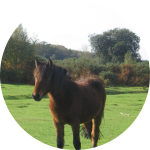| Home |
Welcome to the Horse Stall |
|
Horse Stall contains all types of information for Horse Lovers.
There are a number of products branded horse gifts and products.
Horse Articles :: Lameness in Horses
|
Lameness in Horses |
|
Lameness can present itself in a number of different ways and for different reasons; There is more that one area of pain The horses performance drops The horse shows behavioral changes Sometimes assessment of the problem can be challenging if there is no clear reason for the change / drop in performance and associated lameness. Knowing the history of the horse can greatly assist in the diagnosis of the problem. The horses training schedule, length of time taken to reach levels of fitness and types of exercises will help to determine what types of strains and stresses muscles etc, have been put under. When assessing the horse the main aims are to determine whether the problem relates to; Pain Weakness Young horses often show signs of weaknesses possibly relating to being tired. Training programs for youngsters should be relative to growth rate. Neurological defects Clinical Problems Poor shoeing can lead to bilateral foot pain, fetlock pain, hock pain, carpal pain, thoracic lumbar pain, sacroilliac pain, tying up. Good shoeing can assist horses with some minor problems stated above, when they perform. Rider problems A poorly skilled rider can hinder horses when e.g. jumping poor eye coming into a jump can cause a greater strain on horses' muscles / ligaments / joints. This can cause tying up due to weaknesses from this. Horse problems sometimes the horse is just not skilled enough, suitable or has the right temperament for the discipline it is being ridden in. Show Jumping and Dressage. Subtle lameness may only slightly impede the horse's performance and as many injuries tend to be repetitive, accumulating over time. Many trainers prefer to wait until the end of the season to investigate fully into the cause and future treatments. As the season ends and workloads reduce the demands on horses become less, the lameness seen at the height of competition season may be seen less, affecting the horse less. Conformation has a clear impact on injury. Foot balance is essential for this discipline and despite a good farrier being able to shoe to accommodate for problems that may be evident. If a horse has an upright foot concussion related problems can occur more frequently. When training Show Jumpers engagement and collection is required however this can accelerate problems in the thoracic lumbar region as it puts a lot more stress and strain on the area. Forelimbs will be constantly put under a lot of impact pressures, a good rider that stays stable and with a good center of balance will prevent the horse from having to cope with uneven weights as they regain position after a jump. The experience and strength of the horse will, if not suitable for the job, hinder the horse, causing more stresses and strains as it jumps incorrectly due to tiredness and fatigue. The training surface needs to be considered carefully to help rather that slow down the training of the horse. Too hard and concussions can occur, too deep and suspensory injuries can occur. Joint, bone, foot bruising, inflammation of these areas and hoof wall problems are all common when horses are ridden on unsuitable surfaces. When training Dressage horses training schedules are often dependent on the horse's age. The dressage horse will spend a lot of time in the arena performing a lot of gymnastic exercises. Injuries and lameness are often tissue specific rather than concussive. The dressage horse needs to spend a lot of time working towards strengthening in order to not fatigue when performing difficult weight bearing movements. Desmitis in the hind limbs can occur due to the transfer of weight between front and hind limbs if the horse has not built up enough strength. Acute injuries are not often seen, instead, due to the repetitive nature of the training, it is these types of lamenesses that can occur. As the horse spends so long working in the arena, the surface is so important. Consistency and levelness across the entire surface must be maintained. It is worth considering that constant work on a soft surface as found in arena will not stimulate remodeling within the horses bones, important for strength. Training should incorporate work on hard ground occasionally to achieve this. Caution should be taken though not to shock the horse. Author Resource:-> Tammy is a passionate horse rider who loves to advertise the best ways to be looking after horses. Tammy works part time for http://anythingequine.co.uk .
|
Top Horses |
|
| Top Horse Movies | |
Horse Resources |
|
Horse Health |
|
Horse Breeds |
|
More Horses |
|


| Copyright 2005-2021 DR Management All rights reserved |
Dog Gifts | Wildlife Gifts | Handmade Horse Gifts |
